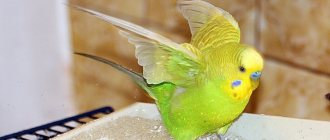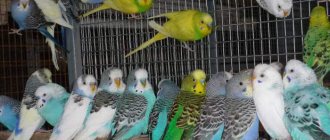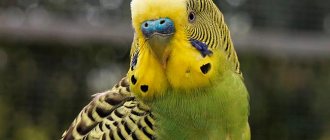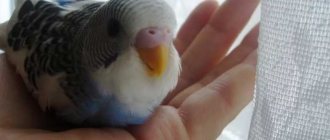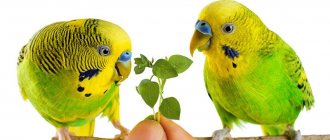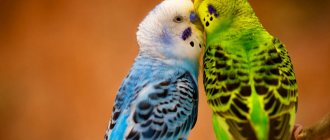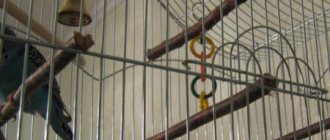Budgerigars do not have vocal cords. They make sounds using the lower larynx, which is located in the thoracic region. The laryngeal muscles and membranes stretch and contract, allowing birds to produce sounds. With their help, wild parrots communicate with each other in a flock, and domestic parrots can imitate human speech.
Parrots do not understand the meaning of words and the meaning of phrases, but they are good at capturing the intonation of the voice and all the sounds of the outside world. Birds have a well-developed memory, they remember dozens of words, and over time they can put them into sentences. To teach a pet parrot to speak, you need to be patient, learn all the intricacies of the process, and follow the rules of training.
Optimal age for training
Budgerigar chicks leave their parent's nest after 1-1.5 months from the date of birth. At this age, the young animals are already free to fly out of the cage and can feed on their own. From this moment on, it is a favorable time to train your pet.
The period of active development usually lasts up to 3.5-4 months, after which the level of concentration begins to gradually decrease. At six months, young birds can already breed, and by 10-12 months they become sexually mature adults. It will be more difficult to train them at this age; you will have to spend more time and effort.
You can find out how young a pet is by looking at the distinctive features of young parrots, namely:
- wavy lines on the head begin from the nose (after the first moult at 3 months, the wavy lines near the beak disappear);
- dark spots near the throat are indistinct, with blurred edges;
- eyes black, without a round white rim;
- the cere (the area above the beak) should be a single color, usually pale pink, blue or purple;
- the tip of the nose is dark or black (after 2 months it begins to lighten);
- the skin on the paws is almost smooth, without convex scales;
- the tail and wing feathers are short.
These signs are enough to understand that the bird is young. If the parameters do not match on at least one point, there is a risk of purchasing an adult parrot.
You cannot begin training immediately after arriving in the house. The bird needs to be given time to get used to its new home and environment. The adaptation time takes on average 2-4 weeks. When close contact has been established, the parrot has become tame and flies freely out of the cage, you can begin training.
Abilities depending on the sex of the parrot
Long-term observations have shown that males learn to speak faster than females. This is due to the way of life of parrots in their natural environment. In the wild, males are active in order to find their mate and attract its attention. The females only have to make a choice and then take care of the chicks.
Domestic birds have adopted this behavior from their wild counterparts. Males are more energetic and inquisitive, so their learning usually goes faster. But the structure of the throat is identical in both sexes, and females are also able to speak well. “Girls” may require more time to study, but they pronounce words more clearly and distinctly than males.
Often the duration of classes and the result depend not on the sex of the bird, but on its character and abilities. There are many naturally gifted parrots. They have a tenacious memory, record frequently repeated words, and begin to repeat them without any training.
Corella (nymph)
The small graceful Australian nymph parrot, or cockatiel, is perhaps the best choice for a beginning birder who dreams of a “talking” pet. It is small in size, inexpensive, fairly unpretentious in content and is quite capable of imitating human speech.
Corella is the closest relative of the cockatoo. This bird naturally lives in flocks in the savannah, and appears in European homes only in the middle of the 19th century and immediately gains great popularity. Moreover, as in the case of the previous parrot, breeders tried to develop many of its colored decorative forms.
With adequate training at home, the cockatiel is quickly tamed and can memorize 100-150 words, as well as simple melodies. Males sing well, imitating street birds - nightingales, tits, magpies. If you are not able to devote a lot of time to the nymph, be sure to buy her relatives for company - otherwise this parrot will quickly get bored and wither away, as it is highly susceptible to stress and mood swings.
Training rules
The main key to success is a trusting relationship with your pet. He should get comfortable in the house, freely fly out of the cage and be willing to be held. Then he will perceive classes as an opportunity to socialize or play. There are a number of rules that will help create the right atmosphere and achieve quick results:
- You need to exercise with your pet when he is healthy, fed and in a good mood. If the parrot is restless, chirping and flapping its wings, it is better to postpone training.
- There should be only one parrot. When there are brothers in the cage, they will communicate with each other in their “bird” language. The birds simply will not pay attention to the owner with his lessons.
- During classes, you need to remove the toys and create silence in the room. Extraneous noises and objects should not distract the bird. Be sure to remove mirrors near the cage - parrots perceive their reflection as a neighbor.
- Start small. Pet “talkers” love sibilant sounds, the letter “r” and voiceless consonants. Of the vowel letters, “o”, “i”, “e”, “a” are easier for them. Choose a short simple word (maximum of 2 syllables). Taking this data into account, you need to choose a nickname for the bird; it’s better to start training with it.
- Exercise daily, preferably in the morning and late afternoon. Lesson time is 5-10 minutes. If the bird listens, tilts its head to the side and tries to make sounds, it is interested, you can study longer. You need to know that what is more important here is not duration, but regularity. It’s better every day for 5-7 minutes than every 3 days for half an hour or more.
- Pronounce the words not loudly, but clearly. Parrots love high pitches, but are frightened by sharp sounds. You can attract women and children - birds perceive their timbre of voice well. It is important that at first someone from the family teaches. When the habit appears, then take turns doing it.
- You can sometimes use voice recording. But when listening, you need to be close to your pet so that contact is not lost. Otherwise, he will quickly begin to perceive the written words as background and will lose interest.
- Monitor your state of mind. The pet senses when the owner is irritated or anxious, and begins to worry too. In such a mood, there will be no benefit from studying; it is better to postpone studying until calm is restored.
- Regardless of the result, the bird should be praised and encouraged. Birds subtly pick up a gentle voice and remember the connection when they receive a treat after class. In the future, they begin to enjoy the lessons and study more willingly and longer.
You should try to accompany everyday actions with the same short phrases, always mentioning your nickname. Very quickly, parrots associate events with sounds, and then reproduce them. Often the words “eat”, “water” or the name of a pet become the first in their dictionary.
The nickname should be simple and short, with hissing sounds. The simpler the name, the faster the bird will begin to respond to it, and then willingly repeat its nickname.
FAQ
Next, we should look at the most frequently asked questions among owners of budgies related to the possibilities of teaching their pets to imitate the sounds of human speech.
Will the bird talk if you turn on voice recording?
Quite often on the Internet, among recommendations on how to teach a parrot to speak, you can find advice on using a voice in a recording. This may not necessarily be the voice of the owner himself. Today, there are special applications with already developed repetitions of certain words and expressions that feathered pets can learn to the greatest extent.
Undoubtedly, training with the help of voice recording is much better than irregular training or no training at all. However, you should not get too carried away with this method. If you turn on the recording too often, your pet will develop a routine attitude towards it, and he simply will not pay any attention to it.
In addition, live, direct communication with the owner regarding the result and the organization of the process itself is much better perceived by the bird.
What words does the wavy remember better?
The anatomy of parrots is, for obvious reasons, significantly different from that of humans. Therefore, the reproduction of sounds by a bird is carried out by completely different mechanisms. In this regard, parrots perceive words with a large number of hissing words well, as well as with the sound “r”.
The words themselves should be small, short, mostly two-syllable. After your pet learns to pronounce simple words, you can move on to learning phrases.
How many words can he learn?
The number of words that a parrot can reproduce is large enough to make logical sentences out of them. However, the concept of “logic” cannot be fully applied to the sounds made by a bird.
Sometimes feathered pets use words at random, uttering completely meaningless phrases. This does not mean that the parrot will not pronounce the correct phrases if you study them not at the level of individual words, but their combinations.
On average, a budgerigar's vocabulary can be several dozen words (about 30-40).
Can you forget all the words
Many parrot owners notice that over time their pets reproduce the sounds of the human voice less and less, gradually forgetting all previously learned words. Many see the reason for this in the maturation of the bird. However, it's not a matter of age.
Indeed, budgies may stop talking, but this happens if the owner stops working with his pet . Thus, in order for the parrot to please the owner with its conversation, you need to regularly train this skill.
In the absence of practice, the bird will forget all the words that it had previously learned. At the same time, it should be noted that teaching an adult bird that has lost the corresponding skill to imitate the sounds of a human voice is much more difficult than a young bird that has not previously spoken at all. This is especially true for females who have previously bred offspring.
Learning process
The first step to success is choosing the right time to study. The schedule must suit both parties. The parrot should be well-fed and active, and the “teacher” should be free from personal affairs. In the future, try to adhere to the established regime - the bird gets used to the activities and tunes in to communicate. Scheduled lessons help you achieve quick results.
The educational process should proceed as follows:
- Clear the cage of toys and mirrors. If the parrot likes to sit on your hand, take off your watch and jewelry so as not to distract its attention.
- Ensure silence in the room.
- Make eye contact with your pet, make sure he is interested and focused.
- Quietly but clearly repeat the chosen word (preferably a name), pausing for 2-3 seconds. Such gaps are needed so that the parrot can record new information.
- Closely monitor your pet's behavior. If he looks at his lips, his head is tilted to the side and his beak opens, then he is interested, you can continue. When he turns his head and flaps his wings, the lesson must end.
- Give a treat, gently praise and pet the pet, finally repeating the word being learned several times.
The bird gets used to regular exercise in a few days, then the training time can be set according to its mood. On some days, the “student” loses interest after just 5 minutes, and on other days he is ready to listen to the lesson for 20-30 minutes. You must act according to his behavior.
The first word is difficult. It may take from 2 weeks to 3 months, the speed largely depends on the abilities of the bird. When this stage is passed, the parrot learns the next words easier and faster. After 10-12 months, many already speak phrases of 3-5 words.
The teaching method does not require special skills and knowledge. To achieve results, you need to stock up on kindness and patience. Parrots are inquisitive and responsive, they are ready to learn new things if they are fascinated by the process.
The memory of birds is tenacious, but short. The words that the pet has learned must be repeated. Without regular practice, they forget the material they have learned, and it will be much more difficult to teach an adult to speak again.
When the parrot is not alone
If there is more than one parrot in the house, you need to deal with each one separately. The training process should take place in an isolated room so that other birds do not distract from the training. Parrots that live with their fellow parrots take longer to learn to speak than those that live alone. And most often they ignore human speech - they have enough communication with their relatives.
The result is successful when a pair is added to an already talking parrot. It is better if the female learns the words, and a male is placed with her. Then the “groom” tries to please his girlfriend and begins to imitate her. The female may also begin to repeat the words after the male, but it usually takes her longer.
Can a bird start talking at home?
Budgerigars are not the only birds in the world that can speak using human sounds and putting them into words.
At the same time, many other species of parrots can do this better and much more consciously.
However, budgerigars are the most common and suitable for home keeping, so many of their owners are concerned about the possibility of teaching the bird to talk.
If we approach this issue with all rigor, then the sounds of budgies cannot be called a conversation. This is just an imitation of what was previously heard. With the same success, parrots can imitate other sounds they like.
To teach a budgie, it is not enough that it simply hears everyday human speech, although some birds are capable of this. To achieve the result desired by the owner, the parrot needs to be dealt with purposefully.
It should be noted that feathered pets can have both different personalities and different learning abilities. Thus, if a bird is not inclined to talk, then it is almost impossible to teach it.
It is almost impossible to determine at the time of purchase whether the pet will be talkative or not. These will become clear only from the results of classes with her. At the same time, it should be noted that the gender and age of the pet indirectly influence learning abilities, which will be discussed later.
It is also useful to read: Is it necessary to cover a parrot’s cage at night?
How to teach an adult parrot to speak
The learning process for an adult parrot is the same as for a young one. The only difference is that it will take more time. Especially for birds who have had negative experiences in the past. They are often wary and fearful. It is difficult for them to adapt to the new home and begin to trust its residents.
It is difficult for such “wounded” birds to even get close to a person, so first they need to be accustomed to the situation. When the pet understands that he is loved and protected here, then you can carefully and unobtrusively begin to learn the first word. You can wait 4-6 months or more for results. The main condition is not to force things and practice regularly.
The age of a bird is not always the determining factor in its ability to speak. It is important that at first the pet is alone in the cage, otherwise he will devote all his time to his other half.
Choosing a pet
We didn’t decide on a dog or a cat right away; fish and hamsters are past stages from our childhood. Therefore, the choice fell on a bird, and if we take it, then a talking bird! The most budget option is a budgie. That's what they decided on. And then one fine day my husband brought home a parrot, Kesha.
Kesha immediately became everyone's favorite: he was not afraid of hands, flew all over the apartment, punched paper with his beak and gently bit his earlobe. He learned to enter the cage on command, with the help of a pointer: he jumped on it as soon as it was brought to him, and from this perch he meekly jumped into his house. But no matter how much we repeated: “Kesha is good,” the parrot remained silent. The bird was extremely stubborn and silent, he didn’t even chirp!
What not to do while studying
Wrong actions can forever discourage a parrot from mastering speech techniques. To avoid annoying mistakes, you must follow the following instructions:
- do not torment the bird with lessons when it is sick, anxious or hungry;
- do not conduct classes in a bad mood;
- do not choose complex words and phrases, start learning with a simple word;
- do not raise your voice at your pet, do not scold him and communicate only in a gentle, friendly tone;
- Do not teach a lesson with the TV on or listening to music;
- do not ignore your pet’s wishes if he clearly makes it clear that he is tired and does not want to exercise anymore.
It is very important to observe the parrot. By his behavior, he often demonstrates his willingness to communicate unscheduled. If a bird sits on your hand or shoulder, seeks attention, or puts its beak on its lips and mutters, you need to willingly support the game and “talk” with your pet. The more time you can spend together, the faster he will talk.
We continue to teach Volnistik conversation
During training, you need to pay attention to your intonation. Birds are great at sensing a person's mood.
So, you need to talk to birds emotionally (kindly, kindly), but not shout - this will scare away the parrot. And monotonous speech can quickly get boring for them.
It is worth paying attention to the reaction of a budgie to certain words. If he gets worried, starts running fussily from side to side, or reacts in some other way, then this word is like a signal
It is better not to say it again during training.
Exercises with budgies should be enjoyed. Organize activities in the form of a conversation, that is, treat your pet as if you were a small child.
It is necessary to pronounce a word or phrase at least ten times during the entire lesson, but do not mindlessly jabber. You always need to maintain emotional intonation so that the parrot is interested in listening. The parrot expresses its interest by its attentive gaze, following you during training, and by fluffing its feathers.
It is important to notice the budgerigar's attempts to speak and reward his efforts with some kind of treat. This will encourage the bird to repeat the learned word over and over again.
At first, the wavy will simply open its beak, watching you speak. Then he will try to repeat the sound that he heard from you earlier.
You can’t scold a bird when it doesn’t succeed or it’s just silent
Patience is important in training, and such emotional outbursts will only further push the bird away from classes and the desire to speak.
In order for a budgie to learn to say, for example, the word “delicious” when feeding, you need to repeat this word exactly when you put food in the feeder. If you want your feathered pet to say other phrases, in other situations you must also repeat those words that you would like to hear from the parrot later.
Budgerigars that have already learned to speak several words tend to form new words by swapping syllables in one word or syllables in different words. For example, from the phrase “Roma, hello,” the parrot comes out “roaring.”
It is worth noting that parrots remember rhyme well. Try to choose a rhyme in the form of a simple word for each word that you want to teach your pet.
Of course, live communication with a parrot during classes is effective, but in some cases, machine reproduction of your voice is also useful. For example, a voice recording can help if you are away from home for a long time. After all, training with a parrot should only be carried out by one person whom the bird trusts.
Words and phrases for parrot
An important first step is to choose the right name. There are many suitable nicknames for birds. In addition to the famous “Kesh”, “Gosha” and “Roma”, the following nicknames are popular:
- Richie;
- Shusha;
- Grisha;
- Chicha;
- Shura;
- Archie;
- Tosha.
When the parrot has learned to say its name, a word denoting an action is added to it. It is better to choose words that are spoken several times daily. For example, these are: “hello”, “eat”, “sleep”, “drink”, “swim”, “walk”, “water”, “toy”.
After mastering 2-word phrases, you can complicate the task. Popular phrases that are easier for parrots to learn:
- Everything will be fine;
- Good afternoon;
- do not make noise;
- Good night;
- I like you;
- How are you doing;
- look for a gift;
- behave yourself;
- Tosha is good;
- How are you doing.
Budgerigars are intelligent and talkative by nature. When they overcome the difficulties in learning the first words, these birds are later able to read poetry or sing songs (“I play the harmonica...”, “Antoshka, let’s go dig potatoes...”, “I walked quietly, walked, walked, and found a pie...” and others).
Budgerigars are able to imitate the murmur of water, the meowing of a cat, or the barking of a dog. To teach your pet to talk, you need to establish a warm, trusting relationship with him and exercise regularly. Parrots always respond to kindness and care, and one fine morning the long-awaited “Hello!” will surely be heard. or “Everything will be fine!”
The torment of the unknown
We stared at Kesha, trying with all our might to determine the color of his wax. It was a completely incomprehensible color: pale lilac-grayish. Luckily for us, we didn’t see any distinct white spots around the nostrils! There was nothing to do but wait.
Photo: Depositphotos
Every day we looked with alarm at the hated wax, hoping that it was about to begin to turn blue and turn blue. But it was not there. The color began to brown and eventually turned brown. Our Kesha turned out to be a girl!
